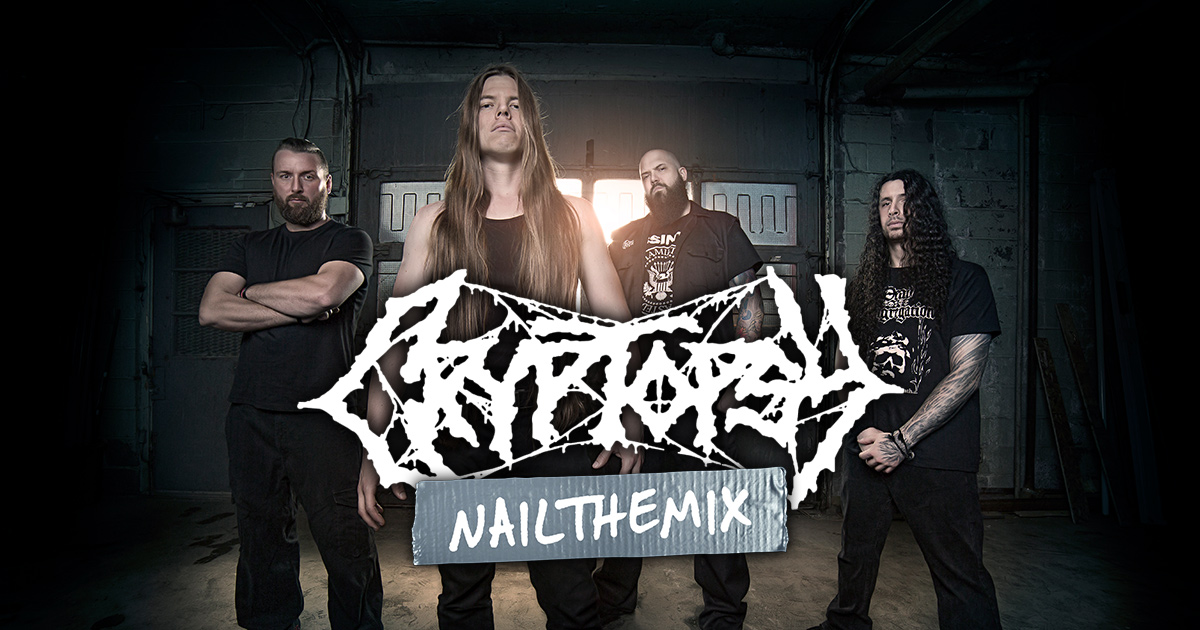
Mixing Cryptopsy’s Brutal Drums with Christian Donaldson
Nail The Mix Staff
Let’s be honest, getting drum toms to sound good in a fast, technical death metal mix is a massive challenge. When you’re dealing with the sheer speed and density of a band like Cryptopsy, tom bleed isn’t just a minor annoyance—it’s a mix-destroying nightmare. The cymbals wash over everything, and a standard gate just can’t keep up without sounding choppy and unnatural. So how do you get tight, punchy, and clear toms that cut through the chaos?
Luckily, producer/mixer Christian Donaldson (The Agonist, Shadow of Intent, Despised Icon) dropped some absolute gold on how he wrangled the iconic Cryptopsy drums. This deep dive comes straight from his session, showing the exact techniques he used to make the toms hit like a truck. Forget basic gating; we’re talking about a multi-layered approach involving key spikes, surgical EQ, and a killer split-processing trick that will change how you mix toms.
The Foundation: Taming the Tom Bleed
Before you can even think about EQ or compression, you have to deal with the bleed. In a mix this dense, the cymbal spill in the tom mics is so aggressive that you simply can’t work with it. The solution isn’t just a heavier gate; it’s a smarter one.
Using Key Spikes for Surgical Gating
Christian’s first move is to create a separate trigger track, often called “key spikes.” This is a new audio track where you place a short, sharp transient sample (a “spike”) perfectly in time with every single tom hit. Instead of having the gate on the tom track listen to the messy original audio, you set the gate’s “key input” to listen to this clean spike track instead.
This way, the gate opens precisely when the tom is hit and closes immediately after, completely ignoring the cymbal bleed in between hits. It’s a fundamental move for achieving clean, isolated tom tracks in extreme metal.
Shaping the Individual Toms
Once the bleed is under control, the next step is to process each tom individually to make it punchy and consistent. Christian applied a similar chain to each of his five tom tracks, only adjusting the EQ to fit each drum’s tuning.
Dynamic Control and Pre-Gating
To even out the performance, a tool like Sound Radix Drum Leveler is used to control the dynamics, ensuring every hit is powerful. After leveling, he applies the gate (triggered by the key spikes) and even adds a multi-band compressor to specifically gate just the high frequencies, giving him another layer of control over any lingering cymbal hash.
Finding the Fundamental with EQ
This is where the real tone shaping begins. Using a visual EQ like the FabFilter Pro-Q 3, Christian identifies the fundamental frequency—the core note—of each tom and gives it a healthy boost. This is what gives the tom its body and power.
Here’s a look at the fundamentals he found:
- Tom 1: 195 Hz
- Tom 2: 150 Hz
- Tom 3: (Tuned nearly the same as Tom 2)
- Tom 4: 119 Hz
- Tom 5: 87 Hz
While boosting the fundamental, he also carves out the annoying “cardboard” sound (usually in the 300-600 Hz range) and adds a touch of high-end “stick” attack and air with a high shelf. He often reaches for the classic SSL Channel Strip for these broad EQ moves. Mastering these kinds of EQ strategies is crucial for mixing modern metal.
The Game-Changer: The High/Low Split Trick
Okay, here’s the special sauce. Even with perfect gating and EQ, getting both a sharp, cutting attack and a full, resonant decay can be tricky. Christian’s solution is to split the single tom bus into two separate tracks: a “Highs” track and a “Lows” track.
Processing the “High” Toms
On the “Highs” track, the goal is to isolate the pure stick attack.
- Aggressive Gating: The gate is set with a super-fast attack and release. This makes the sound incredibly tight and staccato.
- Radical High-Pass Filter: He then uses an EQ to high-pass the fuck out of it, cutting everything below 1-2 kHz. All that’s left is the sharp, clicking transient of the stick hitting the drum head.
Processing the “Low” Toms
On the “Lows” track, the goal is to capture the drum’s body and resonance.
- Normal Gating: The gate here is set more naturally, with a slower release to let the drum’s decay ring out a bit.
- Aggressive Low-Pass Filter: Symmetrically, he low-passes the fuck out of this track, cutting the fizzy high-end attack and leaving only the warm, low-frequency “boom” and decay.
Blending and Phase Correction
When you blend these two tracks, you get the best of both worlds: the clean, bleed-free attack from the “Highs” track and the full-bodied, resonant decay from the “Lows” track.
Crucial final step: You must check the phase relationship between the two tracks. Play them together and flip the polarity/phase switch on one of them. One position will sound thin and weak, while the other will sound full and powerful. Choose the one that sounds punchier.
Final Touches and Bus Processing
With the core tom sound dialed in, the last steps involve gluing everything together on the main Tom Bus. This is all about applying lots of small moves that add up to a polished, professional sound.
Clipping for Control
To add a bit more perceived volume and tame unruly peaks without losing impact, Christian uses a clipper like JST Clip on both the individual split tracks and the main tom bus. The key is to be subtle—just shaving off the very tips of the transients for a bit more control and aggression.
Tom Bus EQ and Compression
On the main tom bus, a few final EQ tweaks are made: a gentle shelf to add weight, a little top-end for clarity, and a final high-pass filter to remove any unnecessary low-end rumble.
He might also add a touch of bus compression to help glue the toms together and make them feel like a single cohesive unit. Getting the right feel with bus processing can really elevate a mix.

100+ Insanely Detailed Mixing Tutorials
We leave absolutely nothing out, showing you every single step
Bringing It All Together
By combining smart gating, surgical EQ, and this powerful high/low split trick, Christian Donaldson takes a set of raw, bleed-heavy tom tracks and transforms them into a clean, powerful, and brutal force that can stand up to a Cryptopsy onslaught.
Cryptopsy on Nail The Mix
Christian Donaldson mixes Phobophile
Get the Session
These are the kinds of expert techniques you can apply to your own mixes right now. But listening to a pro explain their process is one thing—watching them do it, in real-time, with the actual multitracks in front of them is a whole other level.
With Nail The Mix, you get to be a fly on the wall for exactly that. Every month, you’ll watch world-class producers mix massive songs from scratch, explaining every plugin, setting, and decision along the way. If you want to see exactly how Christian Donaldson applied these techniques and more to the rest of this legendary Cryptopsy track, you can get access to his full, unedited mixing session right now. Stop guessing and start learning from the best in the game. It’s time to unlock your sound and mix modern metal beyond presets.
Get a new set of multi-tracks every month from a world-class artist, a livestream with the producer who mixed it, 100+ tutorials, our exclusive plugins and more
Get Started for $1




